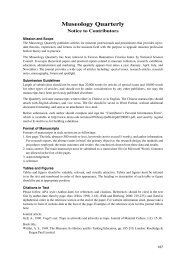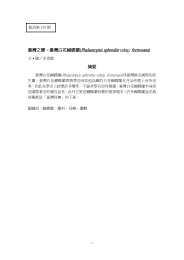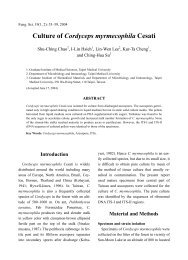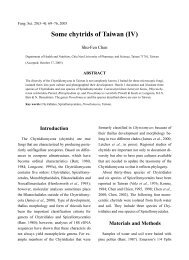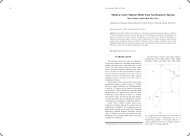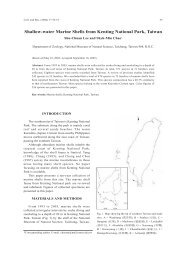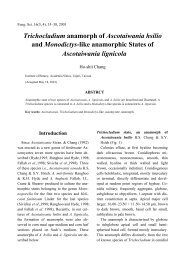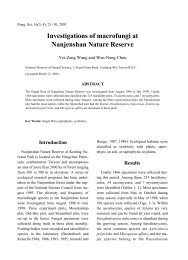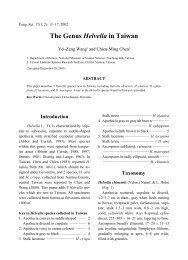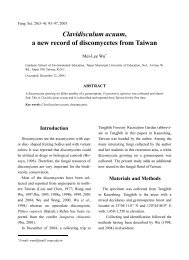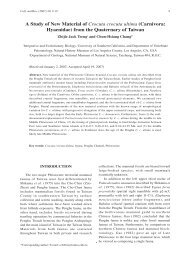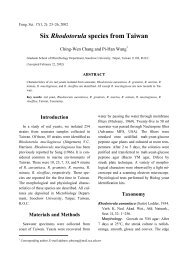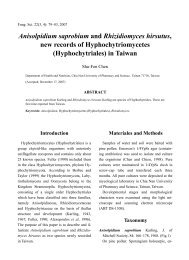One Collection Many Lives: On Curator, Collection, and the Public
One Collection Many Lives: On Curator, Collection, and the Public
One Collection Many Lives: On Curator, Collection, and the Public
Create successful ePaper yourself
Turn your PDF publications into a flip-book with our unique Google optimized e-Paper software.
������������� �����<br />
��������������� � ��<br />
Wing-Yan Vivian Ting*<br />
<strong><strong>On</strong>e</strong> <strong>Collection</strong> <strong>Many</strong> <strong>Lives</strong>: <strong>On</strong> <strong>Curator</strong>,<br />
<strong>Collection</strong>, <strong>and</strong> <strong>the</strong> <strong>Public</strong><br />
Abstract In recent decades, <strong>the</strong> museum sector has reflected upon its visions, missions<br />
<strong>and</strong> objectives, especially in relation to who it is serving <strong>and</strong> how it can exp<strong>and</strong> its<br />
capacity to accommodate diverse socio-cultural needs. This suggests that museums have<br />
transformed from a temple of knowledge to an engaging platform of culture that highlights<br />
civic values, such as social inclusion. Thus, <strong>the</strong> study of museum collection should not only<br />
focus on <strong>the</strong> development of disciplinary research, but also on how curators contextualize<br />
objects to bring enjoyment, education, <strong>and</strong> inspiration to wider audiences. Interestingly,<br />
this new trend in museum services has been criticized as “edutainment” that transforms <strong>the</strong><br />
role of curator from a researcher to an activity organizer. To what extent is such criticism<br />
valid? How can curators balance scholarship <strong>and</strong> public engagement?<br />
This article attempts to address <strong>the</strong>se questions by examining one of <strong>the</strong> key tasks<br />
of curators–interpretation of <strong>the</strong> collection for <strong>the</strong> purposes of education, inspiration,<br />
<strong>and</strong> enjoyment. Based on <strong>the</strong> Chinese collection housed in <strong>the</strong> Bristol City Museum, a<br />
critical review of three different interpretive approaches adopted by curators <strong>and</strong> that<br />
reflect upon <strong>the</strong> relationships among curator, collection, <strong>and</strong> museum visitors was carried<br />
out. An alternative interpretive approach was also considered in which visitors research<br />
<strong>the</strong> collection <strong>and</strong> write creative texts that communicate <strong>the</strong> objects to <strong>the</strong> public. This<br />
approach highlights <strong>the</strong> integration of personal experiences <strong>and</strong> aes<strong>the</strong>tic imagination<br />
into <strong>the</strong> curatorial narrative of <strong>the</strong> collection. The author argues that <strong>the</strong> study of museum<br />
collection should be relevant to contemporary society in connecting audiences with <strong>the</strong><br />
past as well as <strong>the</strong> present.<br />
Keywords: curatorship, museum interpretation, museum social responsibilities, objecthuman<br />
relationship, visitors’ experiences<br />
* Assisstant Professor, Art Administration <strong>and</strong> <strong>Curator</strong>ship in <strong>the</strong> Academy of Visual Arts, Hong Kong<br />
Baptist University; E-mail: wyvting@hkbu.edu.hk; E-mail: wyvting@hkbu.edu.hk<br />
19
������������<br />
Changing Roles of <strong>Curator</strong><br />
Evolving from cabinets of curiosity <strong>and</strong> intellectual displays of an orderly world<br />
view, <strong>the</strong> museum has long been considered as an authoritative caretaker of collections,<br />
preserving, studying <strong>and</strong> exhibiting objects ‘rationally’ in order to articulate material<br />
evidence within a Western system of knowledge making (Hooper-Greenhill, 1992: 192-<br />
194; Bennett, 1995: 24, 34-35; Duncan, 1995: 13-20). The development of modern<br />
museums implies that curator should be an expert who scrutinises every detail of an<br />
object’s provenance <strong>and</strong> construct a rational order of things within specific disciplinary<br />
framework (Pearce, 1992: 119).<br />
In recent decades, many in <strong>the</strong> museum <strong>and</strong> heritage sector have reflected upon its<br />
visions, missions <strong>and</strong> objectives, especially in relation to who it is serving <strong>and</strong> how it<br />
could exp<strong>and</strong> its capacity to accommodate diverse socio-cultural needs within a society<br />
(Kavanagh, 1999; S<strong>and</strong>ell, 2002; Weil, 2002). This institutional reflectivity positions<br />
<strong>the</strong> contemporary museum as a communicative <strong>and</strong> inclusive powerhouse that generates<br />
enjoyment, creativity <strong>and</strong> knowledge <strong>and</strong> urges new thinking about <strong>the</strong> role of museum<br />
collection. Museologists argue that collection from <strong>the</strong> past or from o<strong>the</strong>r cultures could<br />
be relevant to contemporary society <strong>and</strong> advocates ideas, such as equality <strong>and</strong> cultural<br />
tolerance, for <strong>the</strong> betterment of society (Hooper-Greenhill, 2000; Birtley 2002; Donahue<br />
2004; Gurian, 2006). In shaping a new museum culture, governments <strong>and</strong> o<strong>the</strong>r organising<br />
bodies also explicitly express <strong>the</strong> social significance of museum collection in <strong>the</strong>ir policy<br />
statements:<br />
20<br />
Museum collections come from a wide range of sources, <strong>and</strong> can be used to offer<br />
a variety of ways for people to connect with local <strong>and</strong> global concerns. They<br />
have <strong>the</strong> potential to mobilise a range of emotions <strong>and</strong> provide tolerant spaces …<br />
<strong>Collection</strong>s offer means for personal identification <strong>and</strong> discovery. (Department<br />
for Culture, Media <strong>and</strong> Sport, UK, 2005: 14)<br />
Museum usage of collections from contemporary communities requires respect<br />
for human dignity <strong>and</strong> <strong>the</strong> traditions <strong>and</strong> cultures that use such material. Such<br />
collections should be used to promote human well-being, social development,<br />
tolerance, <strong>and</strong> respect by advocating multisocial, multicultural <strong>and</strong> multilingual<br />
expression. (International Council of Museums, 2006: 6.7)<br />
These statements affirm that <strong>the</strong> object can be considered as a mediator between<br />
oneself <strong>and</strong> collective life, enabling <strong>the</strong> museum to play a central role in shaping a new<br />
form of public life. This suggests that curator, <strong>the</strong> caretaker of museum collection who<br />
used to study, manage, <strong>and</strong> care for <strong>the</strong> objects, have taken up new responsibilities –<br />
communicating <strong>the</strong> collection to wider audiences for <strong>the</strong> purpose of promote personal<br />
development <strong>and</strong> civic values. <strong>Curator</strong>s are now <strong>the</strong> collection experts who also have to<br />
take care of visitors’ experiences in connecting with <strong>the</strong> contemporary society. In short,
Wing-Yan Vivian Ting <strong><strong>On</strong>e</strong> <strong>Collection</strong> <strong>Many</strong> <strong>Lives</strong><br />
curators are now project managers whose focuses on collection are shifted to taking care of<br />
wide ranges of people.<br />
The changing role of curator witnesses a new wave of community projects that bring<br />
collection close to <strong>the</strong> people. For instance, <strong>the</strong> Manchester Art Gallery involved a group of<br />
Chinese elders to explore life stories <strong>and</strong> feelings that arose out of selected Chinese objects.<br />
Displayed alongside items from <strong>the</strong> European decorative art collection in <strong>the</strong> new gallery<br />
of craft <strong>and</strong> design, <strong>the</strong> Chinese objects inform <strong>the</strong> ‘Memory’ section by offering personal<br />
meanings that resonate with <strong>the</strong> museum’s social-history narration of how objects interact<br />
with people (Manchester Art Gallery, 2006). In ano<strong>the</strong>r example, <strong>and</strong> despite generally<br />
interpreting objects through words, <strong>the</strong> National Portrait Gallery, London, invited Chinese<br />
families to use <strong>the</strong> photograph collection <strong>and</strong> <strong>the</strong>ir family albums in creating installations<br />
that demonstrated <strong>the</strong>ir family <strong>and</strong> cultural histories (National Portrait Gallery, 2006). It<br />
skillfully implemented <strong>the</strong> Chinese families’ installations into <strong>the</strong>ir interpretation of family<br />
lives in <strong>the</strong> United Kingdom in comparison to <strong>the</strong>ir cities of origin. Focusing on <strong>the</strong> notion<br />
of family, <strong>the</strong> <strong>the</strong>me illustrates how Chinese traditional concepts have been adapted into<br />
contemporary lifestyle <strong>and</strong> urges visitors to reflect on <strong>the</strong>ir family life in a broader context.<br />
Clearly, <strong>the</strong>se community projects underline <strong>the</strong> notion of social inclusion by bringing<br />
a specific group to <strong>the</strong> museum, <strong>and</strong> encourage exchanges among different members of<br />
<strong>the</strong> community through exhibitions. By sharing <strong>the</strong> curatorial power of interpretation,<br />
<strong>the</strong>se projects empower visitors to use <strong>the</strong> collection for exploring personal meanings that<br />
challenge museological order of things. In <strong>the</strong>se projects, curators become <strong>the</strong> facilitator<br />
encouraging visitors to assign personal meanings to <strong>the</strong> collection through researching <strong>the</strong><br />
objects <strong>and</strong> <strong>the</strong>y would be related to personal life experiences. And <strong>the</strong> Chinese collections<br />
are no longer <strong>the</strong> static objects informing people a well-presented history of Chinese art<br />
or culture. Ra<strong>the</strong>r <strong>the</strong>y are active enterprise prompting participants to interweave personal<br />
stories into <strong>the</strong> gr<strong>and</strong> schema of cultural construction <strong>and</strong> create new meanings for <strong>the</strong><br />
objects. These projects highlight a new notion of museum material culture that is multilayered,<br />
creative, <strong>and</strong> intimate, <strong>and</strong> <strong>the</strong> curators are <strong>the</strong> mediators who enable individual<br />
experiences to be weaved into <strong>the</strong> gr<strong>and</strong> narrative of <strong>the</strong> object stories.<br />
Enabling museum collection to connect with people, <strong>the</strong> curators have empowered<br />
<strong>the</strong> communities to have <strong>the</strong>ir voices in exhibitions, <strong>and</strong> presented a glimpse of <strong>the</strong><br />
communities’ experiences to wider museum audiences. It is argued that through <strong>the</strong>se<br />
community projects, curators have transformed museum exhibition to be a ‘contact zone’<br />
where different people, previously separated by historical <strong>and</strong> geographical disjuncture,<br />
could collaborate, interact <strong>and</strong> negotiate various underst<strong>and</strong>ings of culture, history <strong>and</strong><br />
power. However, many museum professionals would consider <strong>the</strong>se projects as ‘fancy<br />
gimmick’ organised by educators <strong>and</strong> outreach officers, that only appeal to visitors with<br />
no prior knowledge or interest. They are concern that democratizing curatorial control of<br />
collection would fail <strong>the</strong> intellectual expectations of <strong>the</strong> museum. Instead of uplifting <strong>the</strong><br />
public intellectually <strong>and</strong> aes<strong>the</strong>tically, <strong>the</strong>y argue that <strong>the</strong>se projects would ‘dumb down’<br />
21
������������<br />
<strong>the</strong> academic st<strong>and</strong>ards that a prestigious institution should uphold, <strong>and</strong> downplay <strong>the</strong><br />
museum’s role as a generator of knowledge. To <strong>the</strong>m, <strong>the</strong>se projects signify that curators<br />
have shifted <strong>the</strong>ir focus from studying <strong>the</strong> collection to working with <strong>the</strong> community. They<br />
question how curators should conceive <strong>the</strong>ir professionalism <strong>and</strong> why curatorial works<br />
should involve socio-cultural issues that may have little connection with <strong>the</strong> collection. It<br />
seems that museum profession are entrapped by different expectations of what a museum<br />
should be, <strong>and</strong> has not yet come to a consensus on what curator can offer to visitors. At <strong>the</strong><br />
core of <strong>the</strong>se questions lies <strong>the</strong> dichotomy of object- <strong>and</strong> people-oriented museum services,<br />
of which <strong>the</strong> former carries, for some, <strong>the</strong> connotation of knowledge dissemination, elitism<br />
<strong>and</strong> intense scholarship, whilst <strong>the</strong> latter signifies to o<strong>the</strong>rs edutainment, popularism <strong>and</strong><br />
community engagement (Ames, 1992; Marstine, 2006).<br />
This article attempts to consider <strong>the</strong>se questions by examining one of <strong>the</strong> key<br />
tasks of curator – interpreting collection that serves wider audiences for <strong>the</strong> purposes of<br />
education, inspiration, <strong>and</strong> enjoyment. I argue that museum objects can be mute, boring,<br />
or intimidating that fails to connect with wide ranges of people about <strong>the</strong> culture <strong>the</strong>y<br />
had been associated with. However, with curator’s interpretation, objects can be versatile<br />
in engaging visitors in a meaningful dialogue. Hence, researching into how museum<br />
collection is interpreted <strong>and</strong> what information has been disseminated in exhibition would<br />
vividly demonstrate <strong>the</strong> changing role of curator.<br />
Based on <strong>the</strong> Chinese collection housed by <strong>the</strong> Bristol City Museum (BCM), it<br />
provides some of <strong>the</strong> background to <strong>the</strong> curatorial approaches of interpretation at <strong>the</strong><br />
museum, <strong>and</strong> in <strong>the</strong> process reflect upon curator’s role in communicating collection to its<br />
audience. By outlining its establishment, missions, <strong>and</strong> interpretive approaches, I critically<br />
review curatorial works would have framed visitors’ underst<strong>and</strong>ing of <strong>the</strong> collection, <strong>and</strong><br />
created various modes of collection-visitors relationship. Considering new museological<br />
thinking that foregrounds civil responsibilities <strong>and</strong> visitors’ experiences, I also discuss my<br />
experiences of organizing <strong>the</strong> Creative Space project, a series of community workshops<br />
that invite participants to write creative labels for exhibition. Reviewing some of <strong>the</strong><br />
labels written by those who may have little interest in or prior knowledge of <strong>the</strong> objects, I<br />
ponder upon what I, as a curator, have learnt from <strong>the</strong> participants <strong>and</strong> consider whe<strong>the</strong>r<br />
community engagement would comprise academic st<strong>and</strong>ard of curatorial works. In <strong>the</strong><br />
conclusion, I argue that curators should not feel intellectually superior because of <strong>the</strong><br />
precious collections <strong>the</strong>y keep, or <strong>the</strong>ir particular expertise. However, <strong>the</strong>ir knowledge <strong>and</strong><br />
passion about objects should inform museum practice in exp<strong>and</strong>ing <strong>the</strong> role of material<br />
culture within <strong>the</strong> context of public life.<br />
Bristol City Museum <strong>and</strong> <strong>the</strong> Schiller <strong>Collection</strong><br />
Opened in 1905, <strong>the</strong> Bristol City Museum (BCM) oversees collections ranging from<br />
archaeology, natural history <strong>and</strong> decorative art, exemplifying disciplinary expertise to its<br />
22
Wing-Yan Vivian Ting <strong><strong>On</strong>e</strong> <strong>Collection</strong> <strong>Many</strong> <strong>Lives</strong><br />
visitors. In 1946, Ferdin<strong>and</strong> Schiller’s collection of Chinese art was donated to <strong>the</strong> BCM<br />
by his bro<strong>the</strong>r Max Schiller <strong>and</strong> an entire gallery was dedicated to it, named after <strong>the</strong><br />
benefactor. The bequest of Ferdin<strong>and</strong> Schiller comprises 438 pieces of Chinese ceramics,<br />
paintings, bronzes <strong>and</strong> jades, among which 27 objects were loaned to <strong>the</strong> Royal Academy’s<br />
seminal ‘International Exhibition of Chinese Art’ in 1935-36. Building upon <strong>the</strong> bequest<br />
– <strong>the</strong> product of twenty-five years’ dedicated collecting - <strong>the</strong> museum has developed a<br />
reputation for demonstrating <strong>the</strong> craftsmanship of Chinese art <strong>and</strong>, <strong>the</strong>refore, is empowered<br />
to exp<strong>and</strong> <strong>the</strong> collection by acquiring o<strong>the</strong>r exquisite pieces from collectors such as<br />
Captain George Warre, Jack Outhwai<strong>the</strong> Thompson, <strong>and</strong> Walter Sedgewick. Most notably,<br />
<strong>the</strong> Museum acquired Burrows Abbey’s collection in 1950, which includes more than 300<br />
pieces of Chinese glass, among which are many objects made by <strong>the</strong> imperial workshop in<br />
Beijing during <strong>the</strong> 18 th century – <strong>the</strong> high point of <strong>the</strong> art. Since <strong>the</strong>n, Schiller’s collection<br />
has been under <strong>the</strong> care firstly of <strong>the</strong> decorative art department <strong>and</strong> <strong>the</strong>n, after 1965, <strong>the</strong><br />
Eastern art department (initially known as <strong>the</strong> Oriental department). As one of <strong>the</strong> most<br />
important private collections of Chinese art in <strong>the</strong> United Kingdom, it was considered to be<br />
‘a notable addition’ to <strong>the</strong> city’s artistic treasures (Schubart, 1948: 3).<br />
The Eastern Art department currently holds about 8000 objects from China, Japan,<br />
Korea, India <strong>and</strong> countries of <strong>the</strong> Middle East. Recently, <strong>the</strong> department has secured some<br />
limited resources in order to attempt to accommodate <strong>the</strong> needs of a wider audience.<br />
Changes in <strong>the</strong> Schiller gallery, however, still indicate a mosaic of interpretive approaches<br />
reflecting museum thinking from early Western connoisseurship to recent educationoriented<br />
interpretation. It is <strong>the</strong>refore, justified that examining different interpretive<br />
approaches of Schiller collection would offer some insights into how curators would<br />
balance scholarship <strong>and</strong> community engagement; <strong>and</strong> reflect upon how curator could create<br />
an enjoyable <strong>and</strong> reflective museum experience that would connect <strong>the</strong> past to <strong>the</strong> living<br />
present.<br />
Schiller’s <strong>Collection</strong> <strong>and</strong> <strong>the</strong> Connoisseurs’ Interpretation<br />
As a collector of Chinese art in <strong>the</strong> early 20 th century, Ferdin<strong>and</strong> Schiller (1866-<br />
1938) may be viewed as one of those pioneers who seriously considered <strong>the</strong>ir collection<br />
choices, rationale <strong>and</strong> categorisation in order to underst<strong>and</strong> non-Western objects from <strong>the</strong><br />
objects’ cultural perspective (Clunas, 1998: 47; Pierson, 2007: 170). Schiller’s collection<br />
demonstrates a comprehensive range of ceramic wares from <strong>the</strong> Neolithic period (4000-<br />
2500BCE) to <strong>the</strong> Qing dynasty (1644-1911), along with jades <strong>and</strong> bronzes. This reflects<br />
an interesting categorisation of ‘Chinese art’ which overlaps painting, <strong>the</strong> most celebrated<br />
form of fine art in <strong>the</strong> West, with decorative art such as ceramics, bronzes <strong>and</strong> jades (Clunas,<br />
1998: 47).<br />
Unlike many collectors of his time, Schiller shared <strong>the</strong> conventional European<br />
sensibilities for decorative painted export wares from <strong>the</strong> Ming (1368-1644) <strong>and</strong> Qing<br />
23
������������<br />
dynasties, but was also aware of Chinese intellectual taste for plain monochromes,<br />
especially <strong>the</strong> white <strong>and</strong> celadon wares from <strong>the</strong> Tang (618-960) <strong>and</strong> Song (960-1279)<br />
dynasties (Schubart, 1948: 5-7). These monochrome wares are perceived by Chinese<br />
scholar collectors as <strong>the</strong> best representation of art, but did not gain much recognition in<br />
<strong>the</strong> UK until Stephen Bushell, one of <strong>the</strong> first British scholars studying Chinese art, Sir<br />
Percival David, <strong>the</strong> renowned collector <strong>and</strong> sinologist, <strong>and</strong> Bernard Leach, <strong>the</strong> prominent<br />
studio potter, promoted a study of <strong>the</strong>ir perfect forms <strong>and</strong> refined qualities (Green, 2000:<br />
45-46; Pierson, 2000: 64-65).<br />
Being eclectic in his approach to <strong>the</strong> very different aes<strong>the</strong>tic notions of China,<br />
Schiller’s collection embraces two very different constructions of Chinese art: <strong>the</strong><br />
decoration-oriented studies of symbolism <strong>and</strong> stories, <strong>and</strong> <strong>the</strong> formalistic appreciation<br />
of forms <strong>and</strong> colours. Schubart, a contemporary of Schiller’s <strong>and</strong> fellow member of <strong>the</strong><br />
Oriental Ceramic Society (OCS), complemented Schiller as a discriminating collector who<br />
tried to balance aes<strong>the</strong>tic interest as well as scholarship (Schubart, 1948: 5).<br />
In approaching Chinese art, Schiller put great emphasis on classification <strong>and</strong><br />
identification in outlining <strong>the</strong> evolution of genres <strong>and</strong> production techniques (Pierson,<br />
2000: 60-62; Clunas, 1998: 43-44). He used a set of technical terminology devised by<br />
Western scholars <strong>and</strong> connoisseurs, paying particular attention to forms. This seems to have<br />
been influenced by his Cambridge acquaintance, Roger Fry, whose notion of ‘significant<br />
form’ demonstrates an early academic attempt to underst<strong>and</strong> non-Western art in a universal<br />
context (BCM, 2003). Renouncing historical context, Fry suggested that viewers look for<br />
<strong>the</strong> formal qualities of an object to coordinate with <strong>and</strong> submerge into sensuous feeling<br />
(Green, 2000: 90-91; Hardie, 2003: 39-40). It is clear from Schiller’s catalogues <strong>and</strong> related<br />
documents, that he methodically documented his purchases, ordering <strong>the</strong>m chronologically<br />
by dynastic period <strong>and</strong> <strong>the</strong>n by purchase within each era. There is a detailed description of<br />
each item, giving details of <strong>the</strong> form, type of ware, compositional techniques, decoration,<br />
condition <strong>and</strong> height (Schiller, 1931).<br />
It is obvious that <strong>the</strong> BCM has encapsulated Schiller’s connoisseurship into its<br />
categorisation, contemporary exhibition setting <strong>and</strong> interpretation. The BCM catalogue,<br />
written in 1948 by his friend <strong>and</strong> fellow OCS member Al He<strong>the</strong>rington, bears a striking<br />
resemblance to Schiller’s documents. For example, <strong>the</strong> tea-dust glazed vase (figure 1) is<br />
described by <strong>the</strong> BCM catalogue as:<br />
24<br />
Vase of bottle shape with rectangular sides. Two elephant h<strong>and</strong>les on upper<br />
neck, covered with an olive-green glaze: Ming dynasty. H. 10” Plate XII N2603.<br />
(Schubart, 1948: 22).<br />
Written in a concise manner, <strong>the</strong> BCM catalogue associates formal qualities with <strong>the</strong><br />
vase, instead of simply using a common name like ‘vase’ <strong>and</strong> relating it to its function.<br />
Unless <strong>the</strong> function of a piece is obvious, this formalistic approach tends to describe objects<br />
as ‘flat jade slab of elongated form’ (Schubart, 1948: 17), ‘depressed globular bowl’ (ibid
Wing-Yan Vivian Ting <strong><strong>On</strong>e</strong> <strong>Collection</strong> <strong>Many</strong> <strong>Lives</strong><br />
Figure 1. Tea-dust glazed vase, Qing dynasty, early 18th<br />
century, 25cm H. (By Ting W Y V, 18 June 2007)<br />
34), or ‘tea bowl of conical shape’ (ibid 31). Looking through <strong>the</strong> 38-page catalogue, <strong>the</strong>re<br />
is no entry mentioning stories or <strong>the</strong> cultural significance of a figure or a narrative motif,<br />
<strong>and</strong> only one note referring to <strong>the</strong> symbolism of a ritual item (ibid 17). The categorisation<br />
stresses form <strong>and</strong> shape, decoration <strong>and</strong> size, in order to identify date <strong>and</strong> <strong>the</strong> type of ware<br />
– <strong>and</strong> somehow overwhelm or exclude <strong>the</strong> piece’s cultural context.<br />
Even today, <strong>the</strong> early connoisseurship of Schiller’s time is reflected in two thirds<br />
of <strong>the</strong> gallery space through <strong>the</strong> display of <strong>the</strong> development of Chinese ceramic wares<br />
<strong>and</strong> a modest collection of ivories <strong>and</strong> bronzes. In <strong>the</strong> glass display cases, each object,<br />
often placed on a wooden st<strong>and</strong> in pseudo-traditional Chinese style, is exhibited against<br />
a contrasting background. The objects are arranged broadly according to <strong>the</strong>ir genre or<br />
production period, but occasionally aes<strong>the</strong>tic factors disrupt <strong>the</strong> typo-temporal order. For<br />
instance, in order to trace technical development of <strong>the</strong> black-glazed wares from various<br />
kiln sites across <strong>the</strong> country, more than ten black tea bowls from <strong>the</strong> Song dynasty are<br />
displayed alongside two black-glazed jars from <strong>the</strong> mid-Tang dynasty (c. eighth century)<br />
<strong>and</strong> three miniature vases from later periods. However, with only one text label focusing<br />
25
������������<br />
on black tea wares <strong>and</strong> <strong>the</strong> cultural practices of tea drinking, it appears to <strong>the</strong> visitor that all<br />
of <strong>the</strong>se objects were produced during <strong>the</strong> Song dynasty <strong>and</strong> somehow related to Chinese<br />
tea culture during that period.<br />
This arbitrary arrangement constructs an artificial rhetoric of objects linking each<br />
piece by its formal qualities, such as colour or glazing method, thus celebrating aes<strong>the</strong>tic<br />
values <strong>and</strong> <strong>the</strong> technical consummation of <strong>the</strong> art, but not <strong>the</strong> culture or makers who<br />
are involved in its construction. Embodying Schiller’s connoisseurship, <strong>the</strong> implicit<br />
museum interpretation seems to struggle with scholarship <strong>and</strong> aes<strong>the</strong>tic considerations.<br />
The interpretation operates through a common language <strong>and</strong> classification shared by<br />
connoisseurs <strong>and</strong> experts. Obviously, it is meant to enshrine <strong>the</strong> beauty of <strong>the</strong> objects by<br />
detailing classificatory information that doesn’t impede visitors’ personal associations.<br />
None<strong>the</strong>less, it does not explain <strong>the</strong> rationale of <strong>the</strong> exhibition, nor suggest what <strong>and</strong> how<br />
to look at <strong>the</strong> collection. In this sense, <strong>the</strong> object is a connoisseur’s specimen, constructing<br />
a typology within a universal context of art. And visitors would have enjoyed <strong>the</strong> collection<br />
if <strong>the</strong>y were to be connoisseur-collectors <strong>the</strong>mselves sharing similar prior knowledge <strong>and</strong><br />
aes<strong>the</strong>tic tastes so that <strong>the</strong>y may decipher <strong>the</strong> rationale of <strong>the</strong> display.<br />
The Sinologist’s Approach<br />
During 1950s, Chinese material culture has undergone a process of institutionalisation<br />
in <strong>the</strong> United Kingdom (Pierson, 2007: 167-177). <strong>Many</strong> of Schiller’s peer collectors started<br />
finding permanent homes for <strong>the</strong>ir collections, choosing ones that could help in shaping<br />
<strong>the</strong> public’s underst<strong>and</strong>ing of Chinese art. For instance, Glasgow received Sir William<br />
Burrell’s collection of over 9,000 works of art in 1944 <strong>and</strong> started building a museum<br />
at Pollok Country Park in 1967 (Pearce, 2004). The British Museum <strong>and</strong> Fitzwilliam<br />
Museum, Cambridge shared Oscar Raphael’s Chinese collection after his death in 1941<br />
(Gray, 1945: 276). This process of specialisation also suggests that curatorial approach<br />
simultaneously shifted away from connoisseurship towards <strong>the</strong> new discoveries of<br />
disciplinary studies.<br />
In <strong>the</strong> case of <strong>the</strong> BCM, <strong>the</strong> specialisation of Chinese material culture at first took<br />
place independently of <strong>the</strong> decorative art department <strong>and</strong> <strong>the</strong> appointment of its curators.<br />
Before that, Schiller’s collection was under <strong>the</strong> charge of Hans Schubart, a well-trained<br />
painting conservator who was keen to fur<strong>the</strong>r exp<strong>and</strong> <strong>the</strong> collection. When <strong>the</strong> Oriental<br />
Art Department was established in 1965, it was managed by Dr Richard Hu See-Yee, an<br />
expert in Buddhism <strong>and</strong> Eastern art, for a few months before he took up a lecturing post in<br />
<strong>the</strong> United States. From 1967 to1997, <strong>the</strong> post was filled by Peter Hardie who specialises<br />
in Chinese glass <strong>and</strong> Sino-Arabian exchange in relation to material culture. When one<br />
compares <strong>the</strong> catalogue of <strong>the</strong> Schiller Gallery published in 1948 to <strong>the</strong> present day display<br />
arrangement, it is clear that Hardie’s professionalism lies in developing interpretive <strong>the</strong>mes<br />
to justify <strong>the</strong> original juxtaposition <strong>and</strong> in enriching <strong>the</strong> displays with text panels. As a<br />
26
Wing-Yan Vivian Ting <strong><strong>On</strong>e</strong> <strong>Collection</strong> <strong>Many</strong> <strong>Lives</strong><br />
keen researcher, his interpretive text features catalogical entries outlining formal qualities<br />
of <strong>the</strong> objects, which would serve as notes for identification. In some cases, <strong>the</strong>re are<br />
supplementary explanatory drawings from Chinese classical texts <strong>and</strong> from recent literature<br />
in <strong>the</strong> field, used to share art historical facts with visitors.<br />
For instance, Hardies’ interpretive text on a yellow bowl from <strong>the</strong> Qing court reads:<br />
Bowl; porcelain; incised on <strong>the</strong> outside with two beardless dragons of classic<br />
Qing type above waves <strong>and</strong> mountains, separated by <strong>the</strong> jewel <strong>and</strong> four-fold<br />
cloud; base bears <strong>the</strong> au<strong>the</strong>ntic under-glaze blue seal mark of <strong>the</strong> Dao Guang<br />
Emperor (r. 1821-1850) of <strong>the</strong> Qing (Manchu) dynasty of China.<br />
Yellow is <strong>the</strong> colour of <strong>the</strong> Centre <strong>and</strong> <strong>the</strong> Earth; <strong>and</strong> of <strong>the</strong> Emperor of China.<br />
Yellow dragons are <strong>the</strong> senior of <strong>the</strong> Four Dragons, say <strong>the</strong> Rui Ying Tu (a work<br />
lost by <strong>the</strong> C +6), <strong>and</strong> it was a yellow dragon that presented <strong>the</strong> Emperor Shun<br />
with <strong>the</strong> Diagram (of <strong>the</strong> Eight Trigrams: see our section on <strong>the</strong> View of Nature).<br />
By summarising <strong>the</strong> decorative features of this bowl, this catalogue style entry<br />
would help collectors or art historians to recognise <strong>the</strong> dragon motif as a sample of classic<br />
Qing type <strong>and</strong> to identify its date by <strong>the</strong> style of <strong>the</strong> reign mark inscribed on its base. To<br />
collectors or art historians, this is a valuable piece of information. However, to visitors<br />
with limited interest in or prior knowledge of <strong>the</strong> collection, it is not certain whe<strong>the</strong>r <strong>the</strong>y<br />
would recognise a typical Qing dynasty dragon motif <strong>and</strong> be able to construct a typology<br />
of <strong>the</strong> decoration or monochromes as a whole. Unlike a connoisseur’s interpretation from<br />
<strong>the</strong> earlier period of Schiller et al., this text does not allow visitors to make a free-flowing<br />
dialogue with <strong>the</strong> object. By explaining <strong>the</strong> symbolic meaning of a yellow dragon, it<br />
suggests that visitors should look at <strong>the</strong> relationship between <strong>the</strong> colour of <strong>the</strong> bowl <strong>and</strong> its<br />
decoration. To illustrate why <strong>the</strong> imperial court would make a decoration like this for <strong>the</strong><br />
emperor, this brief paragraph is packed with <strong>the</strong> symbolism of <strong>the</strong> colour yellow <strong>and</strong> <strong>the</strong><br />
dragon motif, <strong>and</strong> its relation to <strong>the</strong> Eight Trigrams, <strong>the</strong> mythical power of nature. These<br />
are supported by <strong>the</strong> Chinese ancient script, ‘Rui Ying Tu’, literally, The Work of Divine<br />
Sign <strong>and</strong> <strong>the</strong> legendary origin of <strong>the</strong> diagram. As <strong>the</strong> text does not fur<strong>the</strong>r explain <strong>the</strong>se<br />
concepts <strong>and</strong> <strong>the</strong> Chinese words, it is doubtful whe<strong>the</strong>r general visitors would be interested<br />
in reading <strong>the</strong> text <strong>and</strong> able to grasp its meanings fully; to do so requires an initial interest<br />
in or prior knowledge of <strong>the</strong> collection. It seems that <strong>the</strong> interpretive text aims to present<br />
authoritative information drawn from <strong>the</strong> original Chinese text, but has less concern with<br />
communicating with visitors.<br />
Though <strong>the</strong> text is anonymous, one feels a dogmatic expert behind <strong>the</strong> scene, making<br />
claims that <strong>the</strong> dragon motif is a ‘classic Qing type’ <strong>and</strong> <strong>the</strong> reign mark to be ‘au<strong>the</strong>ntic’<br />
without necessarily giving any validation. The curatorial authority embodied in <strong>the</strong> text<br />
imposes an ‘art historian’ approach on <strong>the</strong> collection <strong>and</strong> discourages personal <strong>and</strong> multilayered<br />
meaning making. In addition, this expert may be enthusiastic in <strong>the</strong> research, but<br />
27
������������<br />
<strong>the</strong> text is written in a ra<strong>the</strong>r detached <strong>and</strong> plain manner that is accessible to visitors with<br />
knowledge but does not invite <strong>the</strong>m to explore <strong>and</strong> enjoy <strong>the</strong> object more closely. The text<br />
is an informative narration, but not a critical analysis. It points out <strong>the</strong> symbolic meaning<br />
of <strong>the</strong> dragon, but does not decipher <strong>the</strong> rationale of <strong>the</strong> symbolism, such as <strong>the</strong> cultural<br />
significance of <strong>the</strong> colour yellow, or <strong>the</strong> sensuous effect of <strong>the</strong> decoration in conveying <strong>the</strong><br />
notion of royalty.<br />
Looking at a museum object with this kind of curatorial interpretation is, <strong>the</strong>refore, an<br />
intellectual activity that requires visitors to read <strong>the</strong> object as text. Interestingly, <strong>the</strong> label<br />
is also structured in a textbook manner that encourages visitors to refer <strong>the</strong> legend of <strong>the</strong><br />
diagram to ano<strong>the</strong>r section discussing <strong>the</strong> Chinese notion of nature. While <strong>the</strong> label reads<br />
like an authoritative textbook fixing <strong>the</strong> meaning of object in a particular cultural context,<br />
<strong>the</strong> resultant interference of different <strong>the</strong>mes seems to imitate <strong>the</strong> act of reading so that one<br />
goes back <strong>and</strong> forth in <strong>the</strong> gallery as if flipping through different pages within a textbook.<br />
The interpretive text locates <strong>the</strong> object within a disciplinary framework that constructs<br />
values, such as historical significance or technical accomplishment. To a certain extent,<br />
<strong>the</strong>n, <strong>the</strong> rise of specialisations framed objects primarily as a specimen to be carefully<br />
examined, <strong>and</strong> transformed object-human relationships into a knowledge-human dialogue.<br />
In o<strong>the</strong>r words, <strong>the</strong> sinologist’s interpretation embodies intense scholarship to regulate<br />
museum viewing as a form of knowledge seeking behaviour. As Serota (2000: 55) says, in<br />
such an approach object-human communication involves st<strong>and</strong>ing in front of a conveyor<br />
belt of history, but not being involved in its present historicity.<br />
Appreciation of Cultures<br />
In <strong>the</strong>ir shift from connoisseurship to sinology, museums became more conscious<br />
of <strong>the</strong>ir role as facilitator in bridging <strong>the</strong> gap between collections <strong>and</strong> visitors. To<br />
communicate Chinese material culture to wider audiences, museum interpretation has<br />
shifted again, from sinology to a more general appreciation of objects <strong>and</strong> cultures. In<br />
response to museological concerns, <strong>the</strong> BCM has developed a new mission statement<br />
striving to provide an outst<strong>and</strong>ing service that ‘enables <strong>the</strong> people of Bristol <strong>and</strong> beyond<br />
to experience <strong>and</strong> enjoy diverse cultures <strong>and</strong> histories, <strong>and</strong> to underst<strong>and</strong> <strong>the</strong> world <strong>and</strong><br />
<strong>the</strong>ir place in it’ (Bristol Museums, Galleries <strong>and</strong> Archives, 2006). This has been marked<br />
by <strong>the</strong> appointment of a new curator, Kate Newnham, who envisions <strong>the</strong> Schiller gallery<br />
as a community forum sharing a wide range of Eastern art objects with visitors (personal<br />
communication 4 October 2006). Since Newnham took up <strong>the</strong> post in 1998, she has been<br />
working closely with several stakeholders including researchers, community groups <strong>and</strong><br />
schools to develop new interpretive ideas for promoting <strong>the</strong> better use of <strong>the</strong> Schiller<br />
collection.<br />
In 2000, <strong>the</strong> Chinese year of <strong>the</strong> Dragon, Newnham launched a <strong>the</strong>matic exhibition,<br />
‘Dragons in <strong>the</strong> East’, as part of a museum plan gradually to renovate <strong>the</strong> whole exhibition<br />
28
Wing-Yan Vivian Ting <strong><strong>On</strong>e</strong> <strong>Collection</strong> <strong>Many</strong> <strong>Lives</strong><br />
space. Focusing on <strong>the</strong> dragon, one of most popular motifs of <strong>the</strong> Eastern cultures, <strong>the</strong><br />
exhibition juxtaposes objects of diverse media, originating in different countries <strong>and</strong><br />
produced in various time periods. Designed to create a visitor-friendly space, <strong>the</strong> dragon<br />
display uses a brightly coloured backdrop, well-structured labels <strong>and</strong> contemporary<br />
objects, such as Pokemon cards <strong>and</strong> dragon tattoos, to help visitors better associate with<br />
<strong>the</strong> collection. Sliding doors were installed at <strong>the</strong> bottom of some of <strong>the</strong> display cases to<br />
create ‘dragon caves’ where contemporary artefacts in <strong>the</strong> form of dragons or decorated<br />
with dragon motifs are hidden, so that children may be involved in <strong>the</strong> exhibition. To<br />
engage visitors’ participation, a crayon rubbing activity is also provided, while two boxes<br />
of children’s books on dragons <strong>and</strong> Eastern cultures encourage parents to read with <strong>the</strong>ir<br />
children. These facilities suggest that a museum visit involves not merely looking at <strong>the</strong><br />
collection, but participating in <strong>the</strong> exhibition through various activities. The dragon display<br />
can thus be understood as a friendly zone for learning about culture (figure 2).<br />
The innovative combination of objects from various cultures <strong>and</strong> periods that<br />
comprises this exhibition, <strong>the</strong>n, seems an effective visual hook for <strong>the</strong> engaging of visitors.<br />
To evaluate whe<strong>the</strong>r <strong>the</strong> personal relationship with objects facilitated by displays such as<br />
‘dragons in o<strong>the</strong>r cultures’ may be elevated to a more reflective level, <strong>the</strong>n, it is essential to<br />
explore how textual interpretation might facilitate <strong>the</strong> object-human dialogue.<br />
Here is an example of museum interpretation for a trinket box with dragon decoration<br />
(figure 3).<br />
Dennis Noble bought this on holiday in Cumbria this summer. The dragon is a<br />
Western type with large wings. However, like an Eastern one, it has a pearl. You<br />
find dragons acting as guardians in both East Asian <strong>and</strong> European stories.<br />
Keeping within 50 words, <strong>the</strong> text first tells visitors how this box was acquired. Then<br />
it turns to <strong>the</strong> formal qualities of <strong>the</strong> object <strong>and</strong> summarises its European roots, which<br />
Figure 2. Overview of <strong>the</strong> exhibition, ‘Dragon from <strong>the</strong> East’. (By Ting W Y V, 14 September 2006)<br />
29
������������<br />
somehow resembles <strong>the</strong> East Asian tradition. Introducing its social biography <strong>and</strong> <strong>the</strong><br />
cultural significance of its dragon decoration, this text aims to show two different layers<br />
of meanings in helping visitors to associate with <strong>the</strong> object. The former information helps<br />
visitors associate <strong>the</strong> object with personal experiences, whilst <strong>the</strong> latter shows visitors how<br />
to identify <strong>the</strong> difference in style between a Western <strong>and</strong> Eastern dragon. However, as<br />
some visitors have pointed out, <strong>the</strong> interpretation also seems ra<strong>the</strong>r thin: it shows that many<br />
cultures have different depictions of dragons, but fails to explain what attributes <strong>the</strong>se<br />
variations possess. By presenting descriptive facts ra<strong>the</strong>r than critical analysis, <strong>the</strong> text may<br />
succeed in establishing knowledge of dragons ra<strong>the</strong>r than in deconstructing <strong>the</strong>ir fantasy.<br />
It may inspire visitors to ask why, <strong>and</strong> yet does not offer any clues to explore <strong>the</strong> object<br />
fur<strong>the</strong>r.<br />
It should be stressed that apart from fostering accessibility, this popularist<br />
interpretation sets out to promote a better underst<strong>and</strong>ing of Chinese culture. It is <strong>the</strong>refore<br />
appropriate to consider a text for a traditional Chinese object, to review <strong>the</strong> extent to which<br />
it accomplishes its goal. What follows is <strong>the</strong> museum text on a celadon plate with applied<br />
dragon decoration (figure 4), in <strong>the</strong> section of ‘Dragons <strong>and</strong> nature’.<br />
30<br />
Figure 3. Trinket box, 21st century, 8cm H. (By Ting W Y V, 14<br />
September 2006)<br />
This dragon twists round to chase a pearl in <strong>the</strong> water. Dragons were associated<br />
with <strong>the</strong> East <strong>and</strong> with <strong>the</strong> colour ‘blue-green’. The colour on this dish fits <strong>the</strong><br />
description perfectly.
Wing-Yan Vivian Ting <strong><strong>On</strong>e</strong> <strong>Collection</strong> <strong>Many</strong> <strong>Lives</strong><br />
Figure 4. Celadon plate with dragon decoration, Yuan dynasty (1279-1368),<br />
46cm D. (By Ting W Y V, 14 September 2006)<br />
Longquan celadon is a celadon-glazed ware made in Longquan <strong>and</strong> neighbouring<br />
counties in <strong>the</strong> province of Zhejiang. It is renowned for producing a celadon green,<br />
associated with <strong>the</strong> lustrous, yet subtle, hue of jade or <strong>the</strong> magnifying beauty of<br />
mountains (Zhu, 1994 [1774]: 1.99; Liang, 1993 [1723-1815]: 163). Between <strong>the</strong> 12 th<br />
<strong>and</strong> 14 th centuries, <strong>the</strong> skill involved in its construction reached a new height that involved<br />
multiple processes of decoration including <strong>the</strong> application of moulded-relief motifs (Li,<br />
1996: 143, 202). This dish can be considered to be one of <strong>the</strong> refined samples of lowrelief<br />
decoration combined with incised ornaments. Instead of looking at its aes<strong>the</strong>tic<br />
significance, <strong>the</strong> museum text adopts a cultural approach suggesting that <strong>the</strong> dragon has<br />
corresponding colours <strong>and</strong> direction, which can trace its origin from <strong>the</strong> Daoist’s notion of<br />
celestial creatures by <strong>the</strong> second century BCE. According to this Daoist cult, <strong>the</strong> dragon<br />
is considered to be one of <strong>the</strong> four celestial creatures corresponding to a quadrant in <strong>the</strong><br />
ecliptic, encompassing seven mansions of <strong>the</strong> constellation (Qing et al., 1996: 51-54).<br />
To summarise, <strong>the</strong> museum text associates a Yuan dish with an interpretive framework<br />
of Daoist symbolism. It seems confusing that Longquan ware is characterised by its<br />
application of <strong>the</strong> lustrous celadon glaze, despite all of its decorations such as lotus flowers<br />
<strong>and</strong> fish, <strong>and</strong> yet <strong>the</strong> text seems to imply that this dish applies <strong>the</strong> same coloured glaze,<br />
with <strong>the</strong> intention of corresponding with <strong>the</strong> ‘blue-green‘ dragon decoration. To a certain<br />
extent, this over-simplified interpretation misleads visitors into thinking that decorative<br />
motifs in Chinese decorative art are based on symbolism, <strong>and</strong> risks outweighing aes<strong>the</strong>tic<br />
appreciation with cultural readings.<br />
31
������������<br />
By associating <strong>the</strong> object with wider cultural implications, this popularist approach<br />
implies that <strong>the</strong> Chinese collection can be relevant to contemporary life. However, <strong>the</strong>re<br />
is an apparent conflict between sinology <strong>and</strong> accessibility, at best leading visitors to study<br />
information ra<strong>the</strong>r than <strong>the</strong> object itself or, at worst, appealing to spectacular settings that<br />
reduce objects to three-dimensional illustrations of exhibitionary <strong>the</strong>mes. To an extent, this<br />
interpretive approach regards objects as physical representations of its narration of culture<br />
– <strong>and</strong> as a result, risks disconnecting <strong>the</strong> formal qualities of objects from visitors. In o<strong>the</strong>r<br />
words, it shares with visitors a lot of interesting information about <strong>the</strong> host culture, but is<br />
less likely to encourage <strong>the</strong>m to look at an object per se. In this sense, <strong>the</strong> museum text<br />
suggests that <strong>the</strong> object-human relationship be maintained by <strong>the</strong> visitors’ desire to learn.<br />
Again, like <strong>the</strong> sinologist’s approach, communicating material culture is a celebration of<br />
generalised knowledge.<br />
Visitors <strong>and</strong> <strong>Collection</strong><br />
By briefly tracing <strong>the</strong> development of <strong>the</strong> Schiller collection in <strong>the</strong> BCM, I have<br />
outlined three different modes of <strong>the</strong> object-human relationship as constituted by museum<br />
interpretation. The connoisseur’s interpretation is intended to enshrine <strong>the</strong> object with<br />
visitors sharing similar sensibilities; <strong>the</strong> sinologist’s approach aims to focus on <strong>the</strong><br />
significance of disciplinary expertise that requires visitors to learn; whereas <strong>the</strong> popularist<br />
approach tries to communicate cultural information with visitors through diverse facilities.<br />
Apart from <strong>the</strong> connoisseur’s mode, <strong>the</strong> object per se is somehow obscured by knowledge<br />
or information in <strong>the</strong>se object-human dialogues.<br />
It is by no means to be overly critical about <strong>the</strong>se approaches of museum<br />
interpretation. These approaches of museum interpretation, informed by <strong>the</strong> development<br />
of Sinology <strong>and</strong> <strong>the</strong> museological thinking at <strong>the</strong> times, have provided information on art<br />
history, cultural fashion or social practice related to <strong>the</strong> collection. They constitute a neat<br />
intellectualization that frames museum objects as specimens, put under expert examination<br />
in a strictly controlled laboratory to construct an order for underst<strong>and</strong>ing human culture.<br />
A piece of Chinese art is thus ceramic work is thus no longer ei<strong>the</strong>r a well-used utensil<br />
conveying a delicate sense of <strong>the</strong> art of living or a fanciful embodiment of an artist’s<br />
passionate bodily action; instead, stripped of sensuous contact it is understood simply as<br />
an example of a genre, demonstrating certain aspects of a practice, a belief or a technique<br />
(Pearce, 1992: 27-28).<br />
However, <strong>the</strong>se texts are less than visitor-friendly in enabling wide ranges of people to<br />
explore <strong>the</strong> collection. According to my survey at <strong>the</strong> BCM, many visitors would consider<br />
<strong>the</strong> collection ‘boring’, ‘lifeless’, or visually uninteresting (Ting, 2009). To better work<br />
with visitors who may not have any insight into <strong>the</strong> collection, I formulated a communityled<br />
project, ‘Creative Space’, in pursuit of creative interpretation that would appeal to a<br />
diverse audience.<br />
32
Creative Space at BCM<br />
Wing-Yan Vivian Ting <strong><strong>On</strong>e</strong> <strong>Collection</strong> <strong>Many</strong> <strong>Lives</strong><br />
The Creative Space project was an outreach programme run in 2006-7, working with<br />
non-regular visitors in order to improve interpretation of Chinese ceramics in <strong>the</strong> Schiller<br />
gallery. To encourage better use of <strong>the</strong> Schiller gallery, Miss Reethah Desai, <strong>the</strong> BCM’s<br />
outreach officer, helped recruit students from two adult colleges: four local students<br />
learning literacy <strong>and</strong> ten ESOL students (English for speakers of o<strong>the</strong>r languages) who<br />
were new immigrants from Africa <strong>and</strong> Eastern Europe. These participants may not have<br />
had any insight into <strong>the</strong> Chinese collection, yet <strong>the</strong>ir involvement was important in helping<br />
<strong>the</strong> museum considers how to accommodate visitors’ diverse needs <strong>and</strong> interests <strong>and</strong><br />
enables <strong>the</strong>m to connect with <strong>the</strong> objects.<br />
In developing participants’ confidence, creativity <strong>and</strong> skills in working with <strong>the</strong><br />
collection, <strong>the</strong> project was divided into three basic units, including an introduction to<br />
Chinese ceramic art, trips to <strong>the</strong> Schiller gallery, <strong>and</strong> label writing. The students were<br />
encouraged to examine formal qualities of Chinese ceramics <strong>and</strong> to associate materiality<br />
with emotions, music <strong>and</strong> personal experiences. Each participant selected a favourite<br />
ceramic piece in <strong>the</strong> Schiller Gallery <strong>and</strong> researched it both factually <strong>and</strong> creatively<br />
through various art media such as music, literature <strong>and</strong> drawing. Inspired by music<br />
clips <strong>and</strong> creative metaphors, <strong>the</strong> participants wrote interpretive labels introducing <strong>the</strong>ir<br />
favourite pieces to a wide range of audiences. Unlike conventional text, <strong>the</strong>ir creative<br />
labels attempted to show looking at ceramics could be personal, sensuous, <strong>and</strong> imaginative,<br />
<strong>and</strong> could inspire o<strong>the</strong>rs to turn to <strong>the</strong>ir own personal histories <strong>and</strong> bodily experiences in<br />
developing an intimate dialogue with objects. Though this may seem to have grounded <strong>the</strong><br />
resulting interpretations within a context of universal aes<strong>the</strong>tics, some of <strong>the</strong> creative ideas<br />
for looking at ceramics were, in fact, drawn from Chinese connoisseurs’ literature <strong>and</strong><br />
accordingly, Chinese cultural <strong>and</strong> aes<strong>the</strong>tic values were subtly introduced into <strong>the</strong> project.<br />
I argue that a community-led project like this would enable <strong>the</strong> participants to explore<br />
<strong>the</strong> collection at <strong>the</strong>ir own pace <strong>and</strong> consequently inform <strong>the</strong> curator as to what would<br />
trigger <strong>the</strong>ir interest <strong>and</strong> how to facilitate meaning making process. In this project, <strong>the</strong><br />
conventional role of curator has shifted from an expert of <strong>the</strong> collection to a facilitator<br />
who assists <strong>the</strong> participants to associate with <strong>the</strong> collection <strong>and</strong> consequently, interpret<br />
<strong>the</strong> objects. This indeed, works in line with <strong>the</strong> contemporary museological thinking that<br />
foregrounds visitors’ experiences <strong>and</strong> civic responsibilities of museum. However, how<br />
would a curator balance scholarship <strong>and</strong> <strong>the</strong> emphasis of accessibility in this project? In<br />
<strong>the</strong> following discussion, I use three samples of creative labels written by <strong>the</strong> participant<br />
to illustrate an alternative approach of interpretation; <strong>and</strong> reflect upon <strong>the</strong> challenges of<br />
working with visitors.<br />
Writing Creative Labels<br />
<strong><strong>On</strong>e</strong> of <strong>the</strong> important outcomes of this community-led project was <strong>the</strong> creative labels<br />
33
������������<br />
written by <strong>the</strong> participants. In <strong>the</strong>se labels, almost half of <strong>the</strong> participants expressed a strong<br />
link between <strong>the</strong>ir favourite objects <strong>and</strong> personal experiences in relation to <strong>the</strong>ir memories,<br />
cultural background <strong>and</strong> life experiences. The rest were inclined to be more aes<strong>the</strong>tic in<br />
exploring creative metaphors <strong>and</strong> personal feelings that were not necessarily related to<br />
<strong>the</strong>ir life experiences or cultural background. Ei<strong>the</strong>r way, <strong>the</strong> labels <strong>the</strong>y produced made<br />
clear that <strong>the</strong> visitors may have had limited prior knowledge or interest in <strong>the</strong> objects but<br />
were able to connect with <strong>the</strong> collection, that broaden our scope of underst<strong>and</strong>ing Chinese<br />
decorative art. This demonstrated that a ra<strong>the</strong>r personal <strong>and</strong> creative interpretation that<br />
include sensations, emotions <strong>and</strong> personal history toge<strong>the</strong>r, would serve as a means of<br />
inspiration to give a free rein to aes<strong>the</strong>tic imaginations; <strong>and</strong>/or a poetic embellishment to<br />
share thoughts with wider audience.<br />
For instance, Yousef, a participant originating in Sudan, selected a ra<strong>the</strong>r unappealing<br />
stoneware vase. As <strong>the</strong> catalogue record does not mention where <strong>and</strong> when this piece<br />
was obtained, or what <strong>the</strong> inscription is about, we knew little about it. Based on its design<br />
<strong>and</strong> rough rendition, it is probably a clay mould used by craftsman from <strong>the</strong> Qing court<br />
to make bronzes. During <strong>the</strong> 17th century, <strong>the</strong> Qing court tried to exert its influence<br />
over <strong>the</strong> Muslim minority concentrated in areas of Northwestern China such as Ningxia<br />
<strong>and</strong> Xinjiang. The court artists, <strong>the</strong>refore, produced many decorative art objects with<br />
distinctive Islamic styles to serve as political symbols highlighting <strong>the</strong> close tie between<br />
<strong>the</strong> central <strong>and</strong> local governments, or as diplomatic gifts issued by <strong>the</strong> court to local nobles.<br />
Regardless of its aes<strong>the</strong>tic or historical significance, Yousef liked <strong>the</strong> vase because it<br />
represented <strong>the</strong> Islamic tradition that is deep-rooted in his country. He stated,<br />
34<br />
I have seen a vase like this in Sudan where it was used as a container for incenseoil<br />
or perfume. Its Arabic inscription, a quote from <strong>the</strong> Qur’an, reads, ‘Glory be<br />
to God’. You would say this when you are amazed by <strong>the</strong> wonders of life. It is<br />
about being thankful all <strong>the</strong> time.<br />
It is certain that <strong>the</strong> vase he saw in Sudan would be a contemporary interpretation<br />
of a traditional work. By showing how people use <strong>the</strong> wares differently, his text has<br />
suggested how ceramic ideas travel across cultures <strong>and</strong> ages – thus bringing a crosscultural<br />
dimension to looking at Chinese ceramics. Moreover, his translation of <strong>the</strong> Qur’an<br />
quote not only shows what <strong>the</strong> scripts mean literally, but also offers a personal insight<br />
into underst<strong>and</strong>ing <strong>the</strong> saying in daily usage <strong>and</strong> life experience. His example shows that<br />
meaning is fluid, <strong>and</strong> can transform from a tool of bronze making, through a souvenir<br />
object projecting one’s affiliation with one’s home country, to a contemporary experience<br />
of religious lessons. His personal experience is <strong>the</strong> key, offering access to <strong>the</strong> unique aspect<br />
of object-human interaction that is less likely to be touched upon by disciplinary research<br />
of material culture. Through his label, Yousef shares with visitors his love <strong>and</strong> respect<br />
towards <strong>the</strong> Islamic tradition as embodied by <strong>the</strong> formal qualities of <strong>the</strong> vase. Thus, <strong>the</strong><br />
stoneware serves as a mediator introducing visitors to Youssef <strong>and</strong> giving <strong>the</strong>m a glimpse
Wing-Yan Vivian Ting <strong><strong>On</strong>e</strong> <strong>Collection</strong> <strong>Many</strong> <strong>Lives</strong><br />
of what matters in his life. This enables <strong>the</strong> exhibition space to be a community forum<br />
embracing <strong>the</strong> different voices of a multi-cultural society.<br />
To fur<strong>the</strong>r justify my conviction that every individual meaning is valid in its own<br />
right, <strong>the</strong> labels written by Emilia offers insight in considering what museum interpretation<br />
could be. Emilia found a black tea bowl with a skeleton leaf design more than a functional<br />
thing for a tea ceremony; <strong>the</strong> bowl became an aes<strong>the</strong>tic means to co-create different<br />
meanings with its viewer. Taking an object’s perspective, her label reads:<br />
I am a black-glazed tea bowl. In <strong>the</strong> past, I felt terribly lonely when nobody<br />
drank tea from me for ages. But since I have been here everything has changed. I<br />
have found my place. I am here for you.<br />
<strong>Many</strong> people look at me <strong>and</strong> see different things depending on <strong>the</strong>ir personality<br />
<strong>and</strong> mood. My yellow decoration reminds <strong>the</strong>m of fire, a gigantic explosion.<br />
Then it’s only disease, death, nothing – Apocalypse. But…<strong>the</strong> yellow imprint is<br />
in a leaf shape. So, <strong>the</strong>re is still hope for new life. What about you? What do you<br />
feel when you look at me?<br />
In <strong>the</strong> museum context, this black tea bowl is usually a sample showing one of <strong>the</strong><br />
technical variations of a genre developed in twelfth century China, or is used as material<br />
evidence demonstrating <strong>the</strong> practice of whipped tea at <strong>the</strong> time. Instead of locating <strong>the</strong><br />
object in its own historical context, Emilia suggests people examine <strong>the</strong> mundane world in<br />
a new light, while enabling <strong>the</strong> object to explain <strong>the</strong> reasons for its survival over time, <strong>and</strong><br />
its entering into ano<strong>the</strong>r form of social life in a museum context. She offers vivid images<br />
concerning <strong>the</strong> formal qualities of <strong>the</strong> bowl: new life begins after some kind of mysterious<br />
explosion that causes disease, death or emptiness. Though o<strong>the</strong>r visitors may not agree<br />
with her interpretation, it is likely that <strong>the</strong>y may start looking at <strong>the</strong> bowl <strong>and</strong> pondering<br />
what its formal qualities, such as a shiny imprint contrasting with a black speckled glaze,<br />
mean creatively. This label suggests that <strong>the</strong>re are myriad ways of approaching ceramics,<br />
if viewers would unleash <strong>the</strong>ir imaginations to look at <strong>the</strong> object per se. Throughout <strong>the</strong><br />
workshops, one of <strong>the</strong> most frequently asked questions from <strong>the</strong> participants was why<br />
<strong>the</strong> BCM invited <strong>the</strong>m, ra<strong>the</strong>r than experts of <strong>the</strong> field to write <strong>the</strong> labels for <strong>the</strong> Schiller<br />
gallery. Emilia’s interpretation shows that answer is in <strong>the</strong> robust aes<strong>the</strong>tic inspirations that<br />
I sought from <strong>the</strong>m in hopes of fostering more intimate <strong>and</strong> provoking dialogues between<br />
museum visitors <strong>and</strong> <strong>the</strong> ceramics.<br />
<strong>On</strong>ce <strong>the</strong> labels were installed in <strong>the</strong> display case, I noticed that visitors who<br />
casually w<strong>and</strong>ered around <strong>the</strong> Schiller gallery were more likely to read <strong>the</strong> creative texts.<br />
Presumably, visual elements of <strong>the</strong> new labels, including clear layout, large font size <strong>and</strong><br />
colourful photo portraits, appealed to <strong>the</strong>se visitors instantly. I interviewed on various<br />
occasions sixteen visitors who had read <strong>the</strong> labels, <strong>and</strong> learned that most visitors had found<br />
<strong>the</strong> labels interesting <strong>and</strong> easy to read. A few visitors even made up <strong>the</strong>ir own stories as<br />
35
������������<br />
inspired by <strong>the</strong> texts.<br />
Personal Meanings v.s. <strong>Public</strong> Interest<br />
It should be evident that <strong>the</strong> notion of metaphors can inspire cultural underst<strong>and</strong>ing,<br />
sensuous pleasure <strong>and</strong>/or aes<strong>the</strong>tic imagination; yet free-flowing association without rein<br />
could also confirm established perceptions <strong>and</strong> deepen misunderst<strong>and</strong>ings – <strong>the</strong>re is a<br />
fine line between freely sharing personal thoughts <strong>and</strong> ideas, <strong>and</strong> presenting information<br />
that could be considered mistaken <strong>and</strong> irrelevant. By encouraging community groups<br />
to share <strong>the</strong>ir personal thoughts <strong>and</strong> aes<strong>the</strong>tics imaginations with o<strong>the</strong>r visitors, <strong>the</strong><br />
curator tries to enhance visitors’ dialogues with objects to be more personal, relevant<br />
<strong>and</strong> vigorous. A problem arises when <strong>the</strong> curator considers personal interpretation to be<br />
trivial or even inappropriate. The institution <strong>the</strong>n feels obliged to take over interpretive<br />
authority so <strong>the</strong> presentation retains its integrity. Yet in safeguarding <strong>the</strong> public’s interest,<br />
<strong>the</strong> curator’s denial of certain personal narratives risks betraying <strong>the</strong> trust of <strong>the</strong> involved<br />
group. Maintaining a strong partnership with communities thus necessitates delicate<br />
communication <strong>and</strong> negotiation. For instance, working with Maria, a participant from <strong>the</strong><br />
literacy group, was a good learning experience in considering how <strong>the</strong> curator can work<br />
with communities.<br />
Maria’s example indicates a complicated question as to what extent creative<br />
association is valid for <strong>the</strong> public as well as for <strong>the</strong> writer. A black tea bowl decorated<br />
with a swirl pattern was not Maria’s favourite object, but she said she wanted to work<br />
on challenging her own aes<strong>the</strong>tic perception. In her notes, she jotted downs words<br />
like ‘gritty’, ‘mouldy’, ‘squiggly patterns’ <strong>and</strong> ‘earthy’ <strong>and</strong> imagined ‘two different<br />
personalities’ embodied by <strong>the</strong> exterior <strong>and</strong> interior of <strong>the</strong> bowl. Maria saw <strong>the</strong> object<br />
as a Native American artifact <strong>and</strong> created a story about how a tribal witch had used this<br />
bowl for making medicine <strong>and</strong> saved a child from a mysterious disease. To her, ‘this bowl<br />
symbolizes a way of walking with <strong>the</strong> earth as opposed to walking upon it… it is <strong>the</strong> way<br />
that being a Native American is mainly from within’. I am reluctant to make such a liberal<br />
connection between Chinese tea ware <strong>and</strong> a Native American notion. Indeed, Maria had<br />
done research into how <strong>the</strong> bowl would have been used in twelfth century China <strong>and</strong><br />
knew that it was related to making whipped tea along with <strong>the</strong> intellectual enjoyment of<br />
tea drinking. However, I failed to convince her not to go with her creative writing, as she<br />
thought it was what <strong>the</strong> museum was asking for. After many negotiations, <strong>and</strong> as o<strong>the</strong>r<br />
participants in <strong>the</strong> group discussed Maria’s writing, I persuaded her to stress that it is a<br />
Chinese object <strong>and</strong> add an extra section explaining why she saw links between <strong>the</strong> two<br />
cultures. I was uncertain about this decision, though it seemed appropriate in <strong>the</strong> context<br />
of helping o<strong>the</strong>r visitors associate with <strong>the</strong> object <strong>and</strong> in showing <strong>the</strong> community that <strong>the</strong><br />
museum truly appreciates <strong>the</strong>ir involvement.<br />
36<br />
There is also a dilemma as to what extent <strong>the</strong> museum should maintain curatorial
Wing-Yan Vivian Ting <strong><strong>On</strong>e</strong> <strong>Collection</strong> <strong>Many</strong> <strong>Lives</strong><br />
control over its interpretation of its collections. <strong>On</strong> <strong>the</strong> one h<strong>and</strong>, <strong>the</strong> museum tries to<br />
democratise its curatorship by encouraging community groups to share <strong>the</strong>ir personal<br />
thoughts <strong>and</strong> stories of objects with o<strong>the</strong>r visitors. <strong>On</strong> <strong>the</strong> o<strong>the</strong>r h<strong>and</strong>, when it considers<br />
personal interpretation to be trivial or even inappropriate, it is almost obliged to take<br />
over interpretive authority so that <strong>the</strong> presentation retains integrity. The problem is that<br />
in safeguarding <strong>the</strong> public’s interest through excellent services, <strong>the</strong> museum’s denial of<br />
certain personal narratives risks defying <strong>the</strong> trust of <strong>the</strong> involved group. Maintaining a<br />
strong partnership with communities necessitates delicate communication <strong>and</strong> negotiation.<br />
<strong>Curator</strong> <strong>and</strong> Communities<br />
Identifying with <strong>the</strong> present trend of museological thinking, I design <strong>the</strong> Creative<br />
Space project to consider how curator would work with communities as well as <strong>the</strong><br />
collection. The process also inspired me to see Chinese ceramics from diverse perspectives<br />
beyond <strong>the</strong> academic framework of art history. I am convinced that <strong>the</strong> museum experience<br />
should be open to feeling, listening <strong>and</strong> imagining, in honour of visitors as co-creators<br />
of an artwork exploring its multiple interpretations. By inviting participants to research<br />
into <strong>the</strong> collection <strong>and</strong> integrate <strong>the</strong>ir personal experiences into <strong>the</strong> curators’ narrative, I<br />
argue that this project does not only serve <strong>the</strong> purpose of engaging with diverse audiences,<br />
but also opens up new potential for interpreting material culture, for instance memories,<br />
individual experiences <strong>and</strong> creative thinking, thus interweaving personal narration into <strong>the</strong><br />
gr<strong>and</strong> schema of cultural construction. It also reminds many non-museum users of <strong>the</strong>ir<br />
ownership rights in using <strong>the</strong> facilities <strong>and</strong> interpreting Chinese material culture.<br />
Through working with <strong>the</strong> communities, I hold that curatorial work could highlight<br />
personal experiences as an empa<strong>the</strong>tic means to underst<strong>and</strong>ing <strong>and</strong> appreciating why<br />
people made such a thing in a particular manner. It is by no means a patronising approach<br />
that denies visitors’ access to intense disciplinary researches, nor is it a spectacular<br />
measure to catch visitors’ attention through sensory stimulations. Ra<strong>the</strong>r, <strong>the</strong> alternative<br />
interpretation intends to demonstrate <strong>the</strong> complexity of material culture in suggesting<br />
that visitors contextualise objects according to personal experiences <strong>and</strong>, hopefully,<br />
piece toge<strong>the</strong>r a more integral view of human interrelationships with <strong>the</strong> surrounding<br />
environment. Although I am aware that personal interpretations may cause confusion<br />
<strong>and</strong> misunderst<strong>and</strong>ings, I argue that <strong>the</strong>se interpretations are as relevant <strong>and</strong> truthful as<br />
<strong>the</strong> museum’s official histories because <strong>the</strong>y allow <strong>and</strong> encourage direct, meaningful<br />
connections to <strong>the</strong> objects. When misunderst<strong>and</strong>ings arise, curator should suggest visitors<br />
to go back to <strong>the</strong> object <strong>and</strong> ‘listen’ carefully to what story it would like to tell.<br />
Conclusion: Object <strong>and</strong> People<br />
Deriving from Latin ‘curare’, <strong>the</strong> term, ‘curator’, literally means ‘to take care of’, or<br />
37
������������<br />
more specifically, a ‘caretaker’. In conventional sense, museum curators are ‘keeper’ who<br />
is in charge of <strong>the</strong> collection through collecting, preserving, documenting, researching<br />
<strong>and</strong> displaying. By interpreting <strong>the</strong> collection through various means, such as exhibition<br />
<strong>and</strong> catalogue, curator becomes <strong>the</strong> propagator of taste <strong>and</strong> knowledge of <strong>the</strong> public<br />
‘good’. In this article, I have outlined three different interpretive approaches, including<br />
<strong>the</strong> connoisseur’, singologist’, <strong>and</strong> popularist’s, adopted by <strong>the</strong> BCM throughout half<br />
a century. It is in no doubt that <strong>the</strong>se interpretative approaches have taken care of <strong>the</strong><br />
collection very well in considering what <strong>the</strong>se objects are <strong>and</strong> how <strong>the</strong>y would inform<br />
wider audiences about <strong>the</strong> culture.<br />
However, it seems that <strong>the</strong>se interpretations have focused on <strong>the</strong> past of <strong>the</strong> collection,<br />
<strong>and</strong> paid less attention of how <strong>the</strong>se objects would be relevant to contemporary society. It is<br />
based on <strong>the</strong> underst<strong>and</strong>ing that Chinese ceramics can tell us how craftsmen, connoisseurs<br />
<strong>and</strong> literati came into bodily contact with <strong>the</strong> object <strong>and</strong> turned it into <strong>the</strong> form <strong>and</strong> shape<br />
we see today in <strong>the</strong> museum exhibition. Despite <strong>the</strong>ir Chinese legacy, Chinese ceramics<br />
can also reveal to us some ‘west side stories’. These include how <strong>the</strong> objects were collected<br />
<strong>and</strong> adopted into museum culture, <strong>and</strong> how <strong>the</strong>y created new meanings for British people<br />
such as Bernard Leach, <strong>the</strong> studio potter, who infused Eastern craftsmanship into <strong>the</strong><br />
development of ceramic art in <strong>the</strong> west, <strong>and</strong> Oscar Wilde, whose unique aes<strong>the</strong>tic taste<br />
included a room decorated with Chinese blue china alongside o<strong>the</strong>r fashionable curios.<br />
How would curator negotiate diverse meanings that associated with <strong>the</strong> collection <strong>and</strong><br />
enable visitors to be part this meaning making process?<br />
Taking an open approach towards interpretation of <strong>the</strong> collection, I have sought to<br />
democratise authoritative interpretation <strong>and</strong> to make collections more relevant to different<br />
sectors of society. Generating ‘object knowledge’ in a different manner, <strong>the</strong> Creative Space<br />
project asks visitors to underst<strong>and</strong> <strong>the</strong> human experiences related to an object, ra<strong>the</strong>r than<br />
study in a detached manner what happen in <strong>the</strong> past. It can be considered as one option<br />
in trying to develop multi-layered dialogues between collections <strong>and</strong> visitors in order<br />
to enable <strong>the</strong> seeing of ourselves <strong>and</strong> <strong>the</strong> past from diverse perspectives. However, this<br />
interpretive approach may risk ignoring <strong>the</strong> formal qualities of objects <strong>and</strong> denying <strong>the</strong><br />
cultural information <strong>the</strong>y can elicit. The challenge is how curator can explore multiply<br />
layered meanings through interaction between <strong>the</strong> curatorial team, <strong>the</strong> collections <strong>and</strong><br />
various community groups.<br />
To learn through trial <strong>and</strong> error, curators should document <strong>and</strong> properly evaluate<br />
related projects in considering a felicitous model of community involvement.<br />
In short, <strong>the</strong>re are myriad equally satisfying approaches that museums can develop<br />
across <strong>the</strong> spectrum of objects- <strong>and</strong> visitors-oriented museum services. The key is that <strong>the</strong><br />
profession is open to any experimental ideas that interweave <strong>the</strong> experiences of objects<br />
<strong>and</strong> people, institutional narration <strong>and</strong> personal meaning making, <strong>and</strong> <strong>the</strong> tangible past <strong>and</strong><br />
ever-changing present, in shaping <strong>the</strong> museum into a communicative platform. Moreover,<br />
38
Wing-Yan Vivian Ting <strong><strong>On</strong>e</strong> <strong>Collection</strong> <strong>Many</strong> <strong>Lives</strong><br />
future research should investigate how different models operate, to what extent <strong>the</strong>y enable<br />
multiple voices to be heard, <strong>and</strong> how general visitors would respond to <strong>the</strong>se projects.<br />
References<br />
Ames, M., 1992. The development of museums in <strong>the</strong> western world: Tensions between<br />
democratization <strong>and</strong> professionalization. In: Cannibal Tours <strong>and</strong> Glass Boxes: The<br />
Anthropology of Museums, pp. 15-24. Vancouver: UBC Press.<br />
Bennett, T., 1995. The Birth of <strong>the</strong> Museum. London: Routledge.<br />
Birtley, M., 2002. A New Definition of “Museum”, INSITE June/July [<strong>On</strong>line available]<br />
http://www.mavic.asn.au/insite/ncmuseum.pdf Accessed on 14 January 2008.<br />
Bristol’s Museums, Galleries <strong>and</strong> Archives, 2006. Memor<strong>and</strong>um. [<strong>On</strong>line available] http://<br />
www.publications.parliament.uk/pa/cm200607/cmselect/ cmcumeds/176/6121902.htm<br />
Accessed on 14 August 2007.<br />
Clunas, C., 1998. China in Britain: The imperial collections. In: Barringer, T. <strong>and</strong> Flynn, T.<br />
(Eds), 1998, Colonialism <strong>and</strong> <strong>the</strong> Object: Empire, Material Culture <strong>and</strong> <strong>the</strong> Museum,<br />
pp. 41-51. London: Routledge.<br />
Department of Culture, Media <strong>and</strong> Sport, 2005. Underst<strong>and</strong>ing <strong>the</strong> Future: Museums <strong>and</strong><br />
<strong>the</strong> 21 st Century. [<strong>On</strong>line available] http://www.culture.gov.uk/images/consultations/<br />
Underst<strong>and</strong>ing<strong>the</strong>Future.pdf Accessed on 29 September 2007.<br />
Donahue, P., 2004. ‘<strong>Collection</strong> = Museum?’ ICOM News, no. 2 [<strong>On</strong>line available] http://<br />
icom.museum/pdf/E_news2004/p4_2004-2.pdf Accessed on 7 February 2008.<br />
Duncan, C., 1995. Civilizing Rituals: Inside <strong>Public</strong> Art Museums. London: Routledge.<br />
Gray, B., 1945. The Oscar Raphael <strong>Collection</strong> for <strong>the</strong> Nation. The Burlington Magazine for<br />
Connoisseurs, 87(512): 276, 278-283.<br />
Green, J., 2000. “A new orientation of ideas”: Collecting <strong>and</strong> <strong>the</strong> taste for early Chinese<br />
Ceramics in Engl<strong>and</strong>: 1921-36. In: Pierson, S. (Ed), 2000, Collecting Chinese Art:<br />
Interpretation <strong>and</strong> Display, pp. 43-56. London: Percival David Foundation.<br />
Gurian, E. H., 2006. A Blurring of <strong>the</strong> Boundaries. In: Civilizing <strong>the</strong> Museum, pp. 171-179.<br />
London: Routledge.<br />
Hardie, P., 2003. Ferdin<strong>and</strong> schiller: Collecting Chinese Art 1913-1936. Journal of Museum<br />
Ethnography, 15: 35-46.<br />
Hooper-Greenhill, E., 1992. Museums <strong>and</strong> <strong>the</strong> Shaping of Knowledge. London: Routledge.<br />
—— , 2000. Speaking for herself? Hinemihi <strong>and</strong> her discourses. In: Museums <strong>and</strong> <strong>the</strong><br />
Interpretation of Visual Culture, pp. 49-75. London: Routledge.<br />
International Council of Museums, 2006. Code of Ethics for Museums. [<strong>On</strong>line available]<br />
http://icom.museum/ethics.html Accessed on 7 February 2008.<br />
Kavanagh, G., 1999. Museums in Partnership. In: Hooper-Greenhill, E. (Ed), 1999, Museum,<br />
Media, Message, pp. 124-138. London: Routledge.<br />
Liang, T., 1993 [1723-1815]. Gutong ciqi kao [Analytical Review of Ancient Bronzes <strong>and</strong><br />
Ceramics ����� ]. Beijing: Guoji wenhua chuban gongsi.<br />
39
������������<br />
Li, He, 1996. Chinese Ceramics: The New St<strong>and</strong>ard Guide from <strong>the</strong> Asian Art Museum of<br />
San Francisco. London: Thames <strong>and</strong> Hudson.<br />
Manchester Art Gallery, 2006. Object Memories. (Information Booklet)<br />
Marstine, J., 2006. Introduction. In: Marstine, J. (Ed), 2006, New Museum Theory <strong>and</strong><br />
Practice: An Introduction, pp. 1-36. Oxford: Blackwell Publishing.<br />
National Portrait Gallery, 2006. Cherish: Chinese Family in Britain (Press Release). [<strong>On</strong>line<br />
available] http://www.npg.org.uk/live/prelcherish.asp Accessed on 27 September 2007.<br />
Pearce, S., 1992. Museums, Objects <strong>and</strong> <strong>Collection</strong>s. London: Leicester.<br />
Pierson, S., 2000. The David <strong>Collection</strong> <strong>and</strong> <strong>the</strong> Historiography of Chinese Ceramics. In:<br />
Pierson, S. (Ed), 2000, Collecting Chinese Art: Interpretation <strong>and</strong> Display, pp. 57-68.<br />
London: Percival David Foundation.<br />
�� , 2007. Collectors, <strong>Collection</strong>s <strong>and</strong> Museums: The Field of Chinese Ceramics in Britain,<br />
pp. 1560-1960. Bern: Peter Lang.<br />
Qing, Xitai (et al.), 1996. Zhongguo daojiaoshi [History of Chinese Taoism ����� ].<br />
Chengdu: Sichuan renmin chu ban she.<br />
S<strong>and</strong>ell, R., 2002. Museums <strong>and</strong> <strong>the</strong> combating of social inequality: Roles, responsibilities,<br />
resistance. In: S<strong>and</strong>ell, R. (Ed), 2002, Museums, Society, Inequality, pp. 3-23. London:<br />
Routledge.<br />
Schiller, F., 1931. Inventory of Chinese Pottery <strong>and</strong> Porcelain. Bristol City Museum <strong>and</strong> Art<br />
Galley, F. P. M. Schiller bequest.<br />
Schubart, H., 1948. The Schiller <strong>Collection</strong> of Chinese Ceramics, Jades <strong>and</strong> Bronzes:<br />
Illustrated Catalogue. Bristol: City Art Gallery.<br />
Serota, N., 2000. Experience of Interpretation: The Dilemma of Museums of Modern Art.<br />
London: Thames <strong>and</strong> Hudson.<br />
Ting, Wingyan, 2009. Communicating Chinese ceramics: A study of material culture <strong>the</strong>ory<br />
in selected museums in Britain. PhD <strong>the</strong>sis. University of Leicester.<br />
Weil, Stephen, 2002. Museums: Can <strong>and</strong> do <strong>the</strong>y make a difference? In: Making Museums<br />
Matter, pp. 55-74. Washington <strong>and</strong> London: Smithsonsian Institution Press.<br />
Zhu, Yan, 1994 [1774]. Tao shuo [<strong>On</strong> Pottery �� ]. Taipei: Yiwen yinshuguan.<br />
40
��� *<br />
��<br />
* ���������������������<br />
Wing-Yan Vivian Ting <strong><strong>On</strong>e</strong> <strong>Collection</strong> <strong>Many</strong> <strong>Lives</strong><br />
�����������<br />
���������<br />
����������������������������<br />
�������������������������������<br />
�������������������������������<br />
�������������������������������<br />
������������������������������<br />
�������������������������������<br />
�������������������������������<br />
�������������������������������<br />
�������������������������������<br />
�������������<br />
�����������������������������<br />
�������������������������������<br />
�������������������������������<br />
������������������������������<br />
�������������������������������<br />
�������������������������������<br />
������������������������������<br />
��<br />
�������������������������������<br />
����<br />
41



